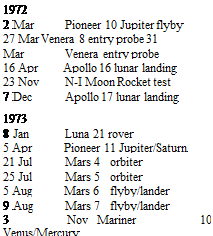Closeouts on a Venus spacecraft, a Moon rocket, and desperation at Mars
TIMELINE: MAR 1972-DEC 1973
The year 1972 opened with the last launch of a 3MV spacecraft, Venera 8, marking the final use of the Molniya launcher for a Soviet lunar or planetary mission. Using Venera 7’s measurement of the temperature at ihe surface, and an inferred pressure, the over-engineered descent capsule was simplified to enable Venera 8 to carry more instruments. It was dispatched on March 27 and the lander operated successfully on the surface of Venus. Two other significant closeouts were in 1972, the launch of the fourth N-l rocket in November whose failure led to that project being canceled, and the final Apollo landing in December.
The second and final robotic lunar rover, Lunokhod 2, was delivered to the Moon by the Luna 21 mission in January 1973. Apart from this, the year 1973 witnessed perhaps the most frustrating campaign in the history of robotic planetary flight. The Soviets were acutely aware of US plans to launch sophisticated orbiter/landers to Mars in 1975. Encouraged by the near-success of the Mars 3 lander, they devised an audacious campaign for 1973. This opportunity was less favorable than that of 1971, which precluded sending orbiter/landers, so instead they launched four spacecraft in July and August: Mars 4 and 5 were orbiters, and Mars 6 and 7 carried landers to be released during flybys. During the development of these spacecraft, the Soviets had incorporated a new transistor into many spacecraft systems. These were discovered before launch to be faulty, with limited lifetimes due to technological “innovations’’ in their manufacture. They could not be trusted to last for the duration of the flight to Mars, yet they could not be replaced in time to achieve the launch window. It was a terrible dilemma. Rather than stand down and wait for the next Mars opportunity in 1975, when the US missions would be launched, the Soviets decided to proceed and hope that at least one of the landers would succeed. But the transistor lifetime tests proved to be accurate, and there were failures in all four spacecraft which ultimately resulted in disaster for this campaign.
W. T. Huntress and M. Y. Marov, Soviet Robots in the Solar System: Mission Technologies and Discoveries, Springer Praxis Hooks 1, DOl 10.1007/978-1-4419-7898-1 13,
© Springer Science+Business Media, LLC 2011
 |
 |
 |
Launch date
Crippled by ailing systems. Mars 4 was unable to enter Mars orbit and sailed past the planet. Mars 5 achieved orbit, but fell silent after only 22 orbits. After an early failure in its telemetry system, the Mars 6 flyby spacecraft had to be commanded in the blind. It miraculously made automated midcourse maneuvers, optical navigation on approaching Mars, and dispatched its entry system on the correct trajectory. The entry system entered the atmosphere, descended by parachute, and sent back mostly garbled data on its compromised communications system. Contact was lost when the lander was released near the surface. The Mars 7 flyby spacecraft released its entry system as planned, but this failed to function and missed the planet. The lack of any real results from this massive campaign was not explained until after the collapse of the USSR.
Meanwhile the US launched Pioneer 10 on March 2, 1972, for the first mission to the outer Solar System. It went on to make a flyby of Jupiter, the largest of planets. In November 1973 Mariner 10 was launched lo use a flyby of Venus for a gravily – assist to reach Mercury. *And Pioneer 11, launched in April 1973, went on to use this same technique at Jupiter lo reach Saturn.










